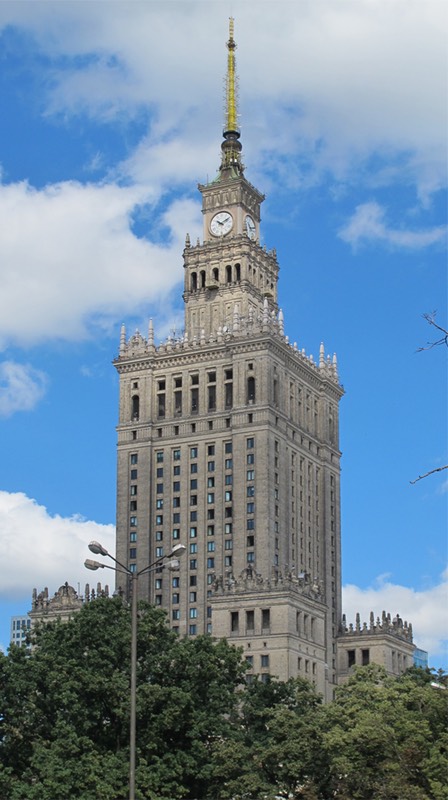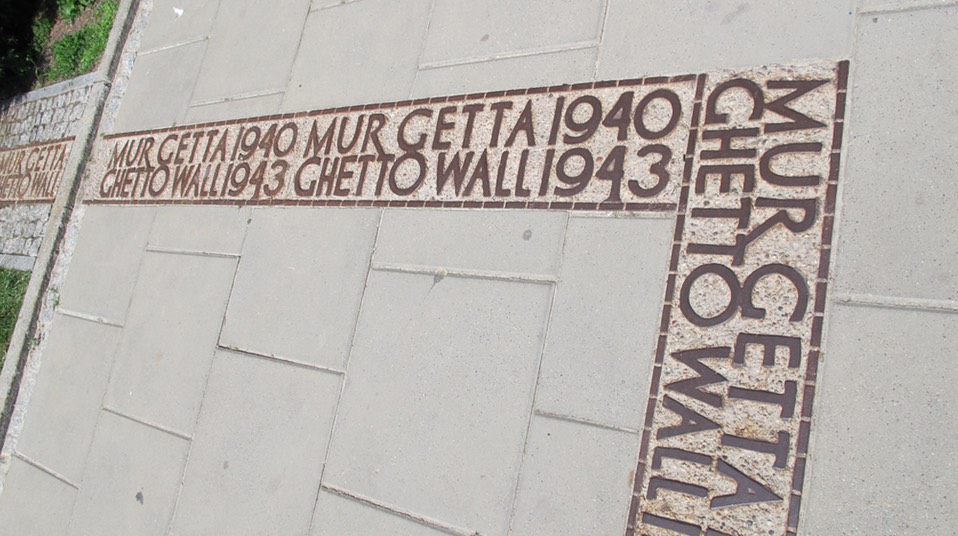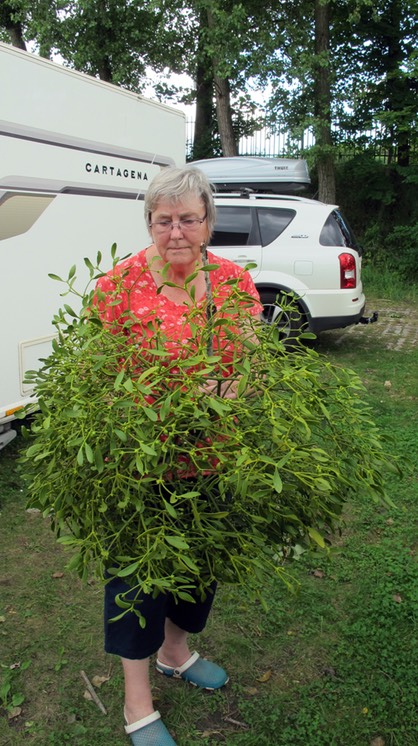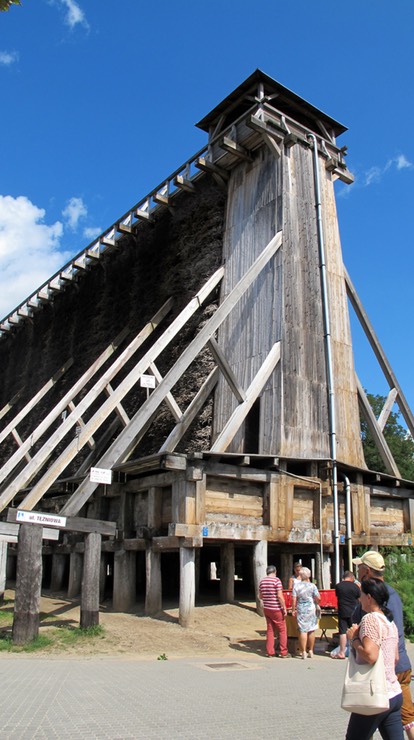7th August - 13th August 2017
Monday
We’re off on holiday!
Having been unable to find a campsite in or around Warsaw that had a half decent review and as there were places Sue particularly wanted to see we decided to go there “on holiday” and stay in an hotel. After much research we chose Hotel Arkadia Royal it supplies a complimentary breakfast, has a restaurant for dinner and most important a bus stop outside with an "every ten minute" bus service to the city centre.
We had dinner in the hotel tonight and it was very good indeed. Sue started with Zurek a soup based on rye flour with mushrooms, sausage and hard boiled eggs while I had a pickled herring starter. For our mains Sue had pork ribs and I had duck both were cooked in a Polish style and both were delicious. To wash it down we had a bottle of Rioja we later realised cost more than the rest of the meal put together including the couple of pre dinner pints - Oh well it was a good bottle of wine.
Tuesday
After a somewhat disturbed night we were a little bleary when we went down for what turned out to be an excellent breakfast. A buffet style you could eat as much, or as little as you wanted, of cereals, fruit juices, yogurts, breads, rolls, meats, cheeses, pates, sausage and scrambled eggs, cakes, biscuits and of course lashings of tea or coffee.
After breakfast we toddled off to Warsaw city centre, the bus stops almost outside the hotel and runs to the bus terminal just a short walk from the city’s “Old Town”. Like much of Warsaw the Old Town was completely destroyed in WW2 but having first class records it was recreated in the 1950’s and 60’s and although certain “improvements” were made it is pretty well indistinguishable from the original.
Our first stop was to the Palace of Culture and Science possibly the most recognisable building in Warsaw. Originally called the Joseph Stalin Palace of Culture and Science it was built as a gift from the Soviet Union to the People of Poland between 1952 and 1955 but in the wake of destalinization the dedication to Stalin was revoked, Stalin's name was removed from the colonnade, interior lobby and one of the building's sculptures.
The tallest building in Poland and one of the tallest in Europe, there is a public viewing gallery on the 30th floor accessed by a modern lift system that, travelling at 6m/sec, is the fastest in Europe, whisking you from ground floor to viewing gallery in 20 seconds. We thought there would be a stomach churning start but there is no sensation of movement at all, without the lights from 1 to 30 flashing on then off in quick succession you would not know you were moving.
As expected the views from each direction are fantastic and there was a great deal of information about the building, the city and its better known residents in English as well as Polish.
Poland as a whole suffered greatly in WW2 and Warsaw suffering was even greater than many other parts of Poland and so it is understandable that many of the recommended places to visit are related to this suffering. One of the reasons we came to Warsaw was to learn a little more about the Warsaw Uprising and the remainder of the day was spent doing just that.
There are less serious places to see in Warsaw but sadly our one day walkabout in the city was at an end. We both thought, despite its many somber aspects that the city was “buzzy and vibrant” and we would like to return someday to explore further, perhaps a “city break” with a hotel in the city centre.
We had another very good dinner in the hotel with starter of steak tartare for me, and caesar salad for Sue, with duck as Sue’s main and a traditional breaded pork chop for me. All delicious.
Wednesday
Our holiday being now over all we had to do now was pack up and drive the 160 odd kilometres back to the caravan but not until after another fab hotel breakfast.
Thursday
We got the top box back on the car and much of the packing done when we got back yesterday, although when the thunderstorm broke early this morning we imagined we would have to stay a day particularly as the forecast said “thunderstorms, high winds and possible tornados”. When we looked at the forecast for where we were going it was sunshine all the way so by 10.30am we were putting the co-ordinates for the next site in the sat-nav and were less than happy when it said distance 400 plus kilometres and journey time nearly six hours. We forced it to search for other routes it came up with one of 330 km with a journey time of just under five hours - thats the one!
Off we went but within a very short distance the sat-nav had added 20 mins for road works here and thirty minutes for road works there. I’ve said before in this blog that Poland seems to be upgrading all its roads, particularly the ones we are on. We had stoppages, we had diversions, we even managed to get lost but when we arrived at Camping Tramp we were within 2 minutes of the first projected time of arrival given us just under five hours before - clever Mr Garmin!!
Friday
Camping Tramp is on the south side of the Vistula River while the medieval town of Torun is on the north, separating the two is a steel bridge around a kilometre or so long. Being so long the middle of the bridge affords good views to north and south. We spent the day exploring the only major Polish town we have so far found that was not damaged or destroyed in WW2. A UNESCO World Heritage site it contains many fine gothic medieval buildings including the home of Nicolaus Copernicus, the Renaissance and Reformation-era mathematician and astronomer who stopped the sun and moved the earth by formulating a model of the universe that placed the Sun rather than the Earth at the centre of the universe.
There was the mother and father of all thunderstorms tonight, the day was very hot with clear blue skies right up until after our dinner, cooked on the BBQ. We were watching TV around 10.00pm when without warning the wind went instantly from zero to “bloody hell”. There is a row of trees 7/8 metres to windward of us and large chunks started to get blown off, including a large ball of mistletoe, around 1.0m diameter and weighing in at over a kilo that landed with a huge crash on the roof, another 30cm from the tree and it would have entered the caravan through the roof light (which was closed!!!) The rain then started along with almost constant thunder and lightening and shortly after that all the power to the site went out and stayed out for a couple of hours. Even when the power was eventually restored it kept flashing on and off for the remainder of the night.
Saturday
Quite a scene this morning, there is a lot of bits of tree spread about the site but although plenty that would have caused damage to a person nothing that would have caused injury to a person inside a caravan or motorhome unless it landed on a roof light. I swept the roof of the remaining mistletoe debris this morning and found a pair of long nose pliers sitting up there. They must have been left when an engineer checked the solar panel sometime in May and have travelled over 1500 miles up there - just shows what a steady driver I am (not - Editor).
Sunday
The salt works and cooling towers at Ciechocinek are a unique set of architectural monument dating back 170 years.
The cooling towers are the largest wooden structures in Europe and serve to remove water from brine.
Three towers, arranged in the shape of a horseshoe, were erected on 7000 oak piles driven into the ground. A spruce and pine construction filled with blackthorn branches was placed on this base. The height of each tower is 15.8m and their joint length is 1741.5m. The cooling towers are used to concentrate the brine in the production of salt. The brine is pumped to the top of the towers where it flows over the blackthorn branches into wooden containers.
During the run-off water is partially evaporated from the brine thus increasing its concentration. The concentrated solution is then taken by pipes to the salt works. The characteristic feature of this process is the forming of a natural aerosol having medical properties. The surrounding area has a specific microclimate rich in iodine and bromine. The salt particles that are also emitted and ozone that is formed, creates a natural therapeutic inhalator.



